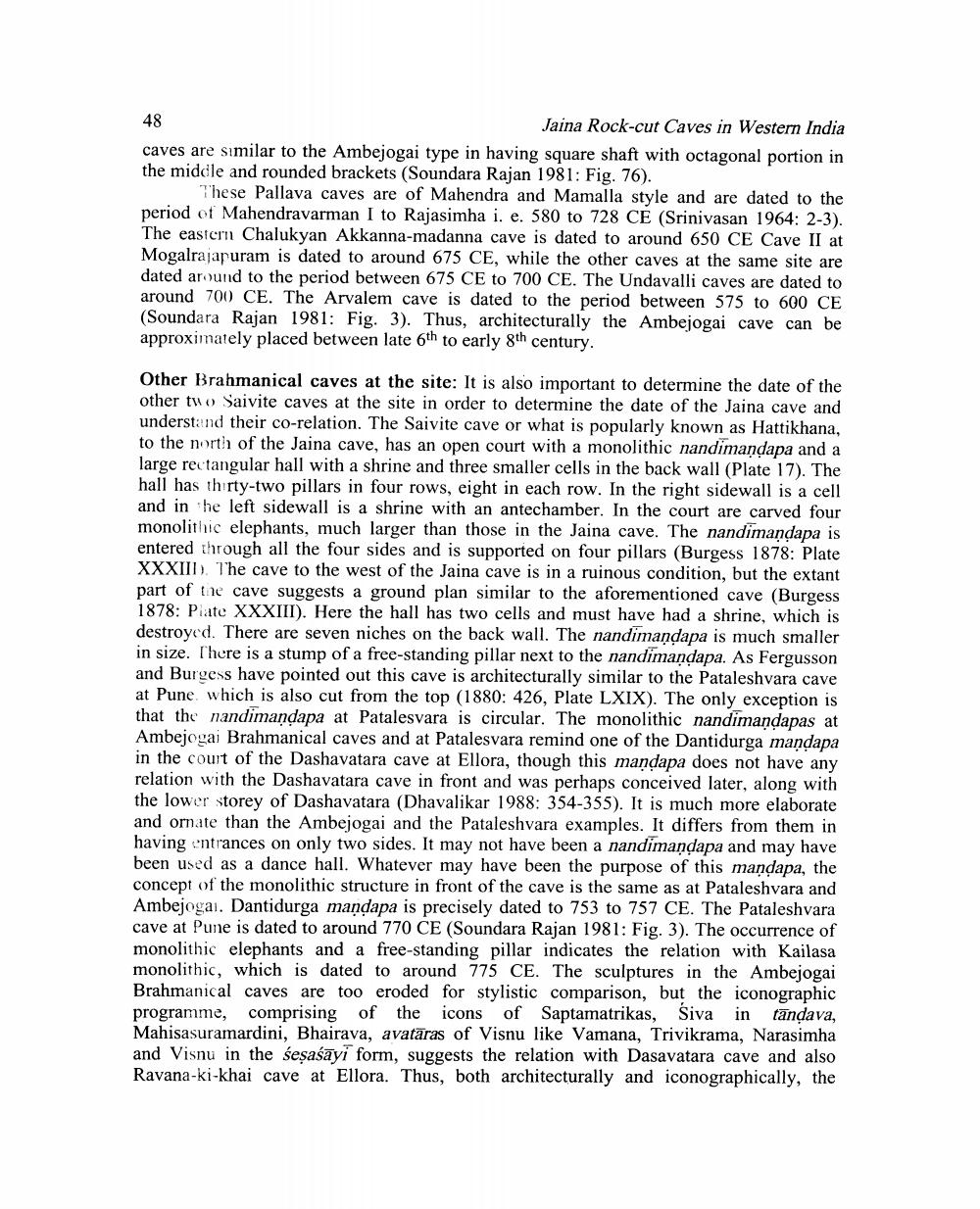________________
48
Jaina Rock-cut Caves in Western India caves are similar to the Ambejogai type in having square shaft with octagonal portion in the middle and rounded brackets (Soundara Rajan 1981: Fig. 76).
These Pallava caves are of Mahendra and Mamalla style and are dated to the period of Mahendravarman I to Rajasimha i. e. 580 to 728 CE (Srinivasan 1964: 2-3). The eastern Chalukyan Akkanna-madanna cave is dated to around 650 CE Cave II at Mogalrajapuram is dated to around 675 CE, while the other caves at the same site are dated around to the period between 675 CE to 700 CE. The Undavalli caves are dated to around 700 CE. The Arvalem cave is dated to the period between 575 to 600 CE (Soundara Rajan 1981: Fig. 3). Thus, architecturally the Ambejogai cave can be approximately placed between late 6th to early 8th century.
Other Brahmanical caves at the site: It is also important to determine the date of the other two Saivite caves at the site in order to determine the date of the Jaina cave and understand their co-relation. The Saivite cave or what is popularly known as Hattikhana, to the north of the Jaina cave, has an open court with a monolithic nandimandapa and a large rectangular hall with a shrine and three smaller cells in the back wall (Plate 17). The hall has thirty-two pillars in four rows, eight in each row. In the right sidewall is a cell and in the left sidewall is a shrine with an antechamber. In the court are carved four monolithic elephants, much larger than those in the Jaina cave. The nandimandapa is entered through all the four sides and is supported on four pillars (Burgess 1878: Plate XXXIII). The cave to the west of the Jaina cave is in a ruinous condition, but the extant part of the cave suggests a ground plan similar to the aforementioned cave (Burgess 1878: Plate XXXIII). Here the hall has two cells and must have had a shrine, which is destroyed. There are seven niches on the back wall. The nandimandapa is much smaller in size. There is a stump of a free-standing pillar next to the nandimandapa. As Fergusson and Burgess have pointed out this cave is architecturally similar to the Pataleshvara cave at Pune which is also cut from the top (1880: 426, Plate LXIX). The only exception is that the nandimandapa at Patalesvara is circular. The monolithic nandimandapas at Ambejogai Brahmanical caves and at Patalesvara remind one of the Dantidurga mandapa in the court of the Dashavatara cave at Ellora, though this mandapa does not have any relation with the Dashavatara cave in front and was perhaps conceived later, along with the lower storey of Dashavatara (Dhavalikar 1988: 354-355). It is much more elaborate and ornate than the Ambejogai and the Pataleshvara examples. It differs from them in having entrances on only two sides. It may not have been a nandimandapa and may have been used as a dance hall. Whatever may have been the purpose of this mandapa, the concept of the monolithic structure in front of the cave is the same as at Pataleshvara and Ambejogai. Dantidurga mandapa is precisely dated to 753 to 757 CE. The Pataleshvara cave at Pune is dated to around 770 CE (Soundara Rajan 1981: Fig. 3). The occurrence of monolithic elephants and a free-standing pillar indicates the relation with Kailasa monolithic, which is dated to around 775 CE. The sculptures in the Ambejogai Brahmanical caves are too eroded for stylistic comparison, but the iconographic programme, comprising of the icons of Saptamatrikas, Siva in tandava, Mahisasuramardini, Bhairava, avatāras of Visnu like Vamana, Trivikrama, Narasimha and Visnu in the seşaśāyi form, suggests the relation with Dasavatara cave and also Ravana-ki-khai cave at Ellora. Thus, both architecturally and iconographically, the




